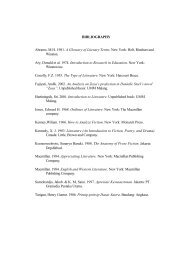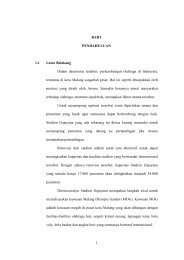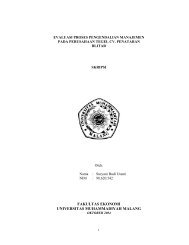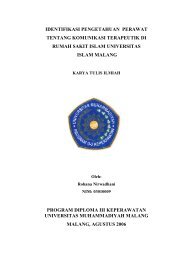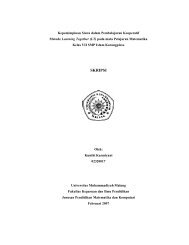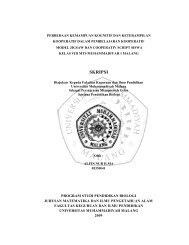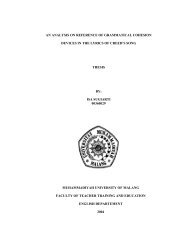File : THESIS.pdf - Universitas Muhammadiyah Malang
File : THESIS.pdf - Universitas Muhammadiyah Malang
File : THESIS.pdf - Universitas Muhammadiyah Malang
You also want an ePaper? Increase the reach of your titles
YUMPU automatically turns print PDFs into web optimized ePapers that Google loves.
0.4 mol dm-3’. It is important to avoid ambiguous descriptions of colour<br />
such as ‘pinkish purple’ or ‘yellowy-green’. Candidates should be able to<br />
describe positive and negative results of the biochemical tests in the syllabus<br />
precisely, using terms such as ‘purple’ for the positive result of biuret test.<br />
Display calculations and reasoning<br />
Candidates should be able to:<br />
• show their working in calculations, and the key steps in their reasoning;<br />
• use the correct number of significant figures for calculated quantities.<br />
Where calculations are done, all of the key stages in the calculation should<br />
be recorded by candidates, so that credit can be given for correctly<br />
displaying working even if the final answer is incorrect. Similarly, where<br />
observations form the basis for logical deduction (e.g. the concentration of<br />
an unknown solution or the identity of an unknown solute), the main steps<br />
in making the deduction should be shown. Again, where inductive thought<br />
processes are used to build up a general prediction or to support a<br />
general theory, from specific observations, the sequence of major steps used<br />
should be reported.<br />
Calculated quantities should be given to the same number of significant<br />
figures as the measured quantity that has the smallest number of<br />
significant figures. For example, if values of time and of volume of gas<br />
collected are measured to 1 and 2 significant figures respectively, then the<br />
calculated rate should be given to 1 significant figure, but not 2 or more.<br />
See http://www.chemsoc.org/networks/learnnet/RSCmeasurements.htm for<br />
more information on significant figures.<br />
Data layout<br />
Candidates should be able to:<br />
• choose a suitable and clear method of presenting the data, e.g.<br />
tabulations, chart, graph, drawing or mixture of methods of presentation;<br />
• select which variable(s) to plot and plot appropriately on clearly labelled xand<br />
y-axes;<br />
• plot all points or bars to an appropriate accuracy;<br />
• follow the IOB recommendations for putting lines on graphs;<br />
Generally, candidates are expected to present data in the form in which the<br />
key points of the data can be most easily visualised:<br />
for quantitative data, this is likely to be<br />
a graph, for qualitative data this may be<br />
a table,<br />
for anatomical or histological data it is likely to be a<br />
drawing. Candidates should:<br />
choose scales for the graph axes that allow the graph to be read<br />
easily, such as 1,<br />
2 or 5 units to a 20 mm square.<br />
make the best use of the space available, using over half of the<br />
length and width of the grid.<br />
make tables of data and observations large enough so that all the<br />
entries can be comfortably fitted in the available space,<br />
make drawings large and un-shaded so that errors are small, and<br />
use fine, clear, unbroken lines, showing clear outlines of structures.<br />
use pencil for drawings, lines on tables and graphs.<br />
The accepted scientific conventions for labelling the axes of a graph are the<br />
same as for the column headings in a table of results with both the<br />
quantity and the unit shown<br />
(where appropriate). Points should be finely drawn with a sharp pencil,<br />
but must still be visible. A fine cross or an encircled dot is suitable; a<br />
thick pencil blob is not. Often it is obvious that the data fall on a straight<br />
line or smooth curve, when a line of best fit or appropriate curve should<br />
be placed on the graph. Sometimes it is not possible to be sure if the line<br />
should be straight or a smooth curve, so adjacent points should be joined by<br />
straight ruled lines in order to represent the data with the minimum of<br />
126



